People Movers
S to Z of Surfing Vehicles Dude
“Surfs up!”
“Dude, how am I gonna get there?”
“Bro, you need a car!”

Summer is here, and surfing is a great lifestyle for getting out, chasing the waves, and getting some immunity-boosting Vitamin D. In fact, any sort of outdoor adventure and exercise will see you a fitter and healthier person for getting out there and doing it. What 2022 cars make for an ideal surfer’s or outdoorsy-person’s companion? The following are several useful vehicles that will transport you, a friend or two, some gear, and surfboards/mountain bikes through something more than just a little puddle, mud or soft sand.
Dedicated vans or MPVs with AWD like the Volkswagen Multivan, LDV G10, Mercedes-Benz V-Class, Kia Carnival, Mercedes-Benz Valente, Volkswagen Caravelle, Honda Odyssey, Hyundai STARIA, Volkswagen California, Toyota Granvia, Mercedes-Benz Marco Polo ACTIVITY, and the Volkswagen Caddy are potentially great for surfing travels with one, two or more mates. Some, but not all, will offer AWD. Depending on how far down onto the beach you want to get your MPV or Van, AWD is definitely the way to go for ensuring you have a better chance of getting through soft sand and out of sticky situations.
For years, station wagons have been a go-to machine for the surfer; for good reason too as they offer plenty of space for lugging gear and for sleeping. Having a vehicle that can get you across country and down onto the beach makes for the ultimate surfer’s vehicle. Outside of the list of MPVs/vans above, there are some great vehicles worth a look if you’re into doing a bit of surfing, fishing and any other type of outdoor adventure.
Here is the best of them from S (Skoda) to V (Volvo). Let us know if we’ve missed anything in between!
Skoda Kodiaq
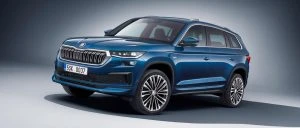
Arguably the best in the business is Skoda’s Kodiaq. It does everything a surfer wants very well. The 2.0-litre Turbo petrol engine is smooth and powerful. 4×4 capability is at the ready, and the Kodiaq Wagon boasts 7-seats and a 7 speed automatic 4×4 gearbox. A 132 kW/320 Nm turbo-petrol is under the bonnet of the base and Sportline variants. The punchy RS packs a 176 kW/500 Nm version of the 2.0-litre engine. The AWD-only Skoda not only offers 3 rows of seats, it is also able to open up 2005 litres of boot space. With standard autonomous emergency braking, adaptive cruise control, a seven-speed dual-clutch gearbox, active LED headlights and a cosy, suede-trimmed interior complete with sat-nav, keyless start, two-zone climate-control and side and rear-window blinds, the Skoda Kodiaq is one very impressive package.
Skoda Superb AWD Scout
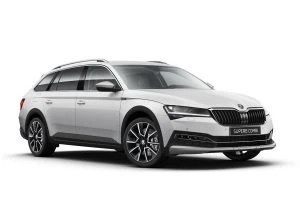
Grab yourself an AWD Skoda Superb Scout crossover wagon and surfing trips just got a whole lot nicer. Under the Scout’s bonnet sits a 200 kW/350 Nm, 2.0-litre turbo petrol engine with a seven-speed dual-clutch gearbox. The spacious, comfortable and high-quality cabin is laden with plenty of soft-touch panels and easy-to-read interfaces. Safety technology includes front and rear autonomous emergency braking, rear cross-traffic alert, lane departure warning with active assist, blind-spot monitoring and self-parking. The Superb Wagons will take 660 litres of luggage, expanding to 1950 litres with the rear seats folded. Towing capacity is rated at 2.2 tonnes.
SsangYong Rexton
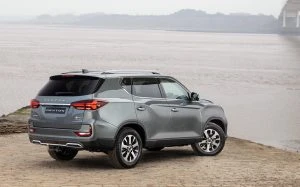
Here’s another strong contender for best surfing wagon. The seven-seater, five-star safe, 8-speed auto, 4×4, 2.2 Diesel-Turbo SsangYong Rexton large SUV uses a 149 kW/441 Nm 2.2-litre turbo-diesel that boasts less than 9 litres/100 km fuel economy. With, all-independent suspension, all-wheel disc brakes and an eight-speed auto gearbox, the big Korean-made SUV is equipped to go bush. Boot space is a handy 1806 litres with second and third rows flat.
Subaru Forester
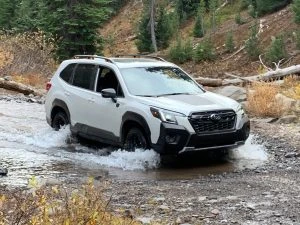
An icon in the surfing fraternity, the Subaru Forester always delivers the goods. 2022 sees the 5-door wagon offer a CVT 7-speed AWD with even autonomous emergency steering standard. This is five-star safe, great on sipping small amounts of fuel and comfortable on any surface of road. The Forester continues with the 136 kW/239 Nm 2.5-litre four-cylinder boxer engine, and the 2.0-litre mild-hybrid claims 6- to 7 litres/100 km. The Forester offers generous levels of passenger space, and the luggage capacity can open to 1768 litres with the rear seats folded. Of course, the Forester is known for going places that Physics suggest it shouldn’t. It is capable off-road, just keep in mind that it’s not a “Landie”!
Subaru Outback
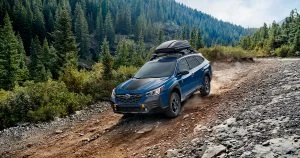
Surprise, surprise, here is another Subaru, and a favourite with surfers. The latest Subaru Outback is the newest of a long line of wagon’s that have carried surfboards and surfers all around the country. Subaru’s Outback is made for the surfer’s design brief, so it will happily go off-road, cruise the open road, accommodate a mattress and provide great accident protection. Five-star safe and comfortable to drive, the 5-door Outback Wagon uses a 138 kW/245 Nm 2.5-litre boxer petrol four-cylinder driving all four wheels through a new CVT transmission. Subaru’s Outback crossover is bigger inside and out, employs the company’s latest global platform and features all the latest safety technology. You can tow up to two-tonnes, and you have a boot with up to 2144 litres!
Toyota
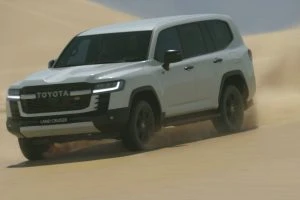
Plenty of choice in the Toyota brand. Take your pick out of the RAV4 (smallest), Kluger, Fortuner, Prado (largest), and Land Cruiser. All will get you far and beyond the tarmac, the Prado and Land Cruiser being truly 4×4 bush bashing capable. Comfortable, reliable, and safe. Boot space starts at around 1800 litres for the RAV4 and gets bigger from here.
Volkswagen Touareg
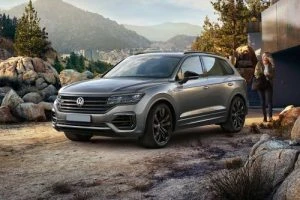
Good things come from VW, as surfers well know – the VW Kombi being a surfing icon. Well-dressed, big and brutish is what many of the ladies like, and the Volkswagen Touareg has it all. Available as a huge 5-door SUV shape, the Touareg boasts five-star safety, 4×4 competence, and a huge boot (over 1800 litres). Passenger space is right up there with the best in the business. It is available with a choice of three diesel engines: two 3.0-litre V6s – 170 kW/500 Nm (170 TDI) and 210 kW/600 Nm (210 TDI), plus a ruthless 310 kW/900 Nm 4.0-litre twin-turbo V8 monster.
VW Tiguan Allspace
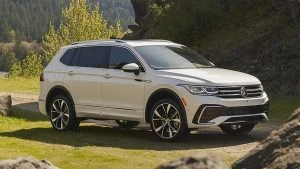
Over 2000 litres of boot space (Allspace version), a practical no-nonsense interior, 5-star safe, comfortable to drive, AWD availability, and the Tiguan starts to make sense. It is also another vehicle that has self-parking capability. With 4MOTION AWD and a dual-clutch six or seven-speed auto transmissions, the Tiguan is an impressive mid-size SUV. The choice of motors is good; a 110 kW/250 Nm 1.4-litre and 162 kW/350 Nm 2.0-litre petrol turbo is available along with the torquey and thrifty 147 TDI 147 kW/400 Nm turbo-diesel.
Volvo XC60
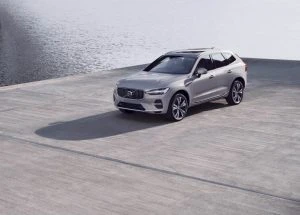
Volvos are amazing cars to drive. They are so comfortable, elegant, and boast all the best tech. Safety is a given, and the XC60 has up to 1792 litres of boot space. Five-door SUV styling, an 8-speed automatic with AWD and you’re away. Volvo’s XC60 SUV line-up is powered by petrol-only mild-hybrid 2.0-litre four-cylinder engines. The R-Design continues with the more powerful 220 kW/420 Nm B6 mild-hybrid powertrain while the Polestar Engineered sticks with the 311 kW/670 Nm T8 Twin Engine plug-in hybrid powertrain. Both are nice and responsive engines.
Volvo XC90
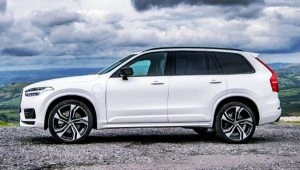
Even with all 7 seats in place, the Volvo XC90 boot can hold up to 302 litres of luggage. Folding down second and third rows makes way for 1856 litres. A superbly comfortable, AWD capable, and delivering huge safety credentials, the new Volvo XC90 is a luxury SUV like no other. All XC90s come with autonomous emergency braking, adaptive cruise control, lane-departure warning/assist, sat-nav, self-parking, AWD, an 8-speed automatic transmission and a fuel-saving idle-stop system. The XC90 D4 is powered by a 173 kW/480 Nm 2.0-litre four-cylinder turbo-diesel. The T6 petrol comes with a 140 kW/400 Nm 2.0-litre four-cylinder turbo-diesel. The 2.0-litre plug-in petrol-electric hybrid XC90 T8 claims an amazing 2.1 litres/100 km fuel consumption and slingshots to 100 km/h in 5.5 seconds!
K to R of Surfing Vehicles Dude
“Surfs up!”
“Dude, how am I gonna get there?”
“Bro, you need a car!”

Summer is here, and surfing is a great lifestyle for getting out, chasing the waves, and getting some immunity-boosting Vitamin D. In fact, any sort of outdoor adventure and exercise will see you a fitter and healthier person for getting out there and doing it. What 2022 cars make for an ideal surfer’s companion? The following are several useful vehicles that, if you’re wanting something to get you places, will transport you, a friend or two, some gear, and surfboards/mountain bikes through something more than just a little puddle, mud or soft sand.
Dedicated vans with AWD or MPVs are potentially great for surfing travels with one, two or more mates. Some, but not all, will offer AWD. Depending on how far down onto the beach you want to get your MPV or Van, AWD is definitely the way to go for getting through soft sand and sticky situations. Having a vehicle that can get you across country and down onto the beach makes for the ultimate surfer’s vehicle.
There are some very good vehicles worth a look if you’re into doing a bit of surfing, fishing and any outdoor adventure. Aside from an AWD Van or AWD MPV, here are the best of them from K (Kia) to R (Renault). Let us know if we’ve missed anything in between!
Kia Sorento

The seven-seat Kia Sorento SUV is one of the most advanced vehicles in its class. If you find parking a mean trick, then it can even park itself without anyone inside. Quiet, roomy and with a large boot, the Sorento is available in Sport, Sport+ and GT-Line and the choice of a front-drive 3.5-litre 200 kW/332 Nm V6 petrol with an eight-speed auto gearbox, an AWD dual-clutch auto 148 kW/440 Nm 2.2-litre four-cylinder turbo-diesel or a 190 kW/350 Nm PHEV. The roomy cabin is enhanced by a commodious 616-litre boot that increases to a massive, all-seats-folded 2011 litres.
Land Rover Defender

Ultimate 4×4 traction. The 2.0-litre D200, D240 and D250 diesels produce 147 kW/430 Nm, 177 kW/430 Nm and 183 kW/570 Nm respectively, while the petrol engines output 221 kW/400 Nm, 294 kW/550 Nm and 386 kW/625 Nm. All Defenders are highly capable, dual-range 4x4s, all driving through an eight-speed auto gearbox. Up to 2231 litres of boot space gives you plenty of space to sleep! 5-star safe.
Land Rover Discovery

Ultimate 4×4 traction with added sophistication. Of course, the Range Rover alternative is luxury to the max! Discoverys are big on comfort and refinement and offer up to 2104 litres of sleeping space. 5-star safe.
LDV D90

A big, cushy, well-priced 7-seater with 5-doors. Sitting on a strong ladder-frame chassis and boasting a punchy 160 kW/480 Nm, 2.0-litre bi-turbo-diesel with an eight-speed auto transmission this is a seriously decent machine. Offering rear-drive or dual-range 4WD with multi-mode terrain selection, off-roading is a breeze. 5-star safe and providing up to 2382 litres of sleeping space.
Mahindra XUV500 W10

A 7-seater with 5 doors and a 6-speed auto, the Mahindra XUV500 SUV is one of the best-value mid-size seven-seaters in Australia. It is powered by a 103 kW/320 Nm 2.2-litre turbo-petrol engine. AWD form is the best version and performs well off-road. Let down only by a 4-star safety rating, the Mahindra has over 700 litres of boot space with the third row seats flat and grows to an excellent mattress in the back material. You also get a five-year/100,000km warranty with five years of roadside assist when bought new.
Mitsubishi Outlander

Mitsubishi’s fourth generation Outlander SUV is a roomy 5-door wagon that is comfortable to drive, has all the modern tech, offering its owner plenty of space. Available in AWD, running with an 8-speed CVT gearbox, and using the new 135 kW/245 Nm 2.5-litre engine this is a reliable unit that will take you and your mates places. Boot space is up to 1461 litres, safety is 5-star, and you also get Mitsubishi’s class-leading 10 year/200,000 km warranty.
Mitsubishi Pajero Sport

Another highly rated surfer’s wagon, the 2022 Mitsubishi Pajero Sport Wagon. With its 8-speed automatic gearbox is smooth. It’s a dual-range unit with Low and High, so 4×4 traction combines with a high ground clearance and long-travel suspension to ensure plenty of off-road capability. There’s heaps of passenger space and it’s surprisingly smooth and comfortable on the road. The Pajero Sport is available in both five and seven-seat form and is powered by a 2.4-litre, 4-cylinder turbo-diesel producing 133 kW/430 Nm. 5-star safety and a boot space that’s huge. The Pajero Sport boasts a big, square cargo space and boasts 673-litres of cargo volume even up to the second row. Fold the second row down as well and it’s cavernous.
Nissan X-Trail

The sharp-looking Nissan X-Trail is a real surfer’s choice. Nissan’s X-Trail continues to rate among the best cargo-carriers in its class. It feels nifty on the road and is five-star safe. The AWD version uses a naturally-aspirated petrol engine with 126 kW/233 Nm. Boot space is huge and close to 2000 litres, enough to lie down and stretch your legs out overnight.
Renault Koleos

A pretty cool looking wagon is the new Koleos from Renault. Nissan’s X-Trail and Renault’s Koleos have teamed up and are based on the same platform. Five-star safe and superbly comfortable, Renault’s five-seat Koleos mid-size SUV combines attractive looks and excellent people and luggage-carrying abilities. There’s a choice, at the top-level for 4WD, and the 126 kW/226 Nm 2.5-litre petrol engine drives through a modern CVT transmission. Boot space is almost 2000 litres!
A to J of Surfing Vehicles Dude
“Surfs up!”
“Dude, how am I gonna get there?”
“Bro, you need a car!”

Summer is here, and surfing is a great lifestyle for getting out, chasing the waves, and getting some immunity-boosting Vitamin D. In fact, any sort of outdoor adventure and exercise will see you a fitter and healthier person for getting out there and doing it. What 2022 cars make for an ideal surfer’s companion? The following are several useful vehicles that, if you’re wanting something to get you places, will transport you, a friend or two, some gear, and surfboards/mountain bikes through something more than just a little puddle, mud or soft sand.
Dedicated vans or MPVs with AWD like the Volkswagen Multivan, LDV G10, Mercedes-Benz V-Class, Kia Carnival, Mercedes-Benz Valente, Volkswagen Caravelle, Honda Odyssey, Hyundai STARIA, Volkswagen California, Toyota Granvia, Mercedes-Benz Marco Polo ACTIVITY, and the Volkswagen Caddy are potentially great for surfing travels with one, two or more mates. Some, but not all, will offer AWD. Depending on how far down onto the beach you want to get your MPV or Van, AWD is definitely the way to go for getting through soft sand and out of sticky situations.
For years, wagons and SUVs have also been a go-to machine for the surfer; for good reason too as they offer plenty of space, the capacity for lugging gear, and for sleeping. But having a vehicle that can get you across country and down onto the beach makes for the ultimate surfer’s vehicle. Outside of the list of vans and MPVs above, there are some great vehicles still worth a look if you’re into doing a bit of surfing, fishing or any type of outdoor adventure.
Here is the best of them, first article of three, from A (Alfa Romeo) to J (Jeep). Let us know if we’ve missed anything in between!
Alfa Romeo Stelvio

Three petrol engines offer the Stelvio between 147–375 kW of power and 330–600 Nm of torque. The 8-speed automatic and 4×4 (AWD) ability make it ideal for heading off tar seal. It has 5-doors, 5-seats, a 5-star ANCAP safety rating, and 1600 litres of boot space when the rear seats are folded flat.
Audi Q Wagons


Audi Q5 and Q7 models are idyllic; the Q3 maybe a little small, however. All of these are stylish, AWD and superbly comfortable. Diesel and petrol engines are available that offer the Q5 and Q7 between 150–251 kW of power and 370–700 Nm of torque. 4×4 (AWD) ability make them perfect for nosing about off-road. Both Q models have 5-doors, 5-seats, and a 5-star ANCAP safety rating. The Q5 has 1530 litres of boot space with the rear seats folded flat; Q7 has 1971 litres.
Audi A6 Allroad

Cargo room extends to 1680 litres with the rear seats folded down, and the AWD Quattro system ensures that you’ll get around secondary roads and the odd track pretty comfortably in an A6 Allroad. A nice wagon to drive, and the surfboard can go on the roof or slide in along the flat cargo area. A sportier drive than a similarly capable Subaru Outback. The Audi A6 Allroad Wagon 45TDI is offered in Australia and runs with a tiptronic 8-speed quattro drive. The 3.0-litre Turbo-Diesel is a peach, packing a healthy 183 kW/600 Nm from its V6 configuration, and scampers from a standstill to 100 km/h in less than 7 seconds.
BMW X3, X5


BMW X3 and X5 models are really nice SUV wagons for open road touring. All are stylish, AWD, and superbly comfortable. Diesel, electric and petrol engines are available for the X3 that offers between 135–285 kW of power and 300–620 Nm of torque. X5 models get between 170 and 460 kW of power and 450–750 Nm of torque. 4×4 (AWD) ability make them handy when getting down to the beach or picnic area. All X models have 5-doors, 5-seats, a 5-star ANCAP safety rating, and the X3 has 1600 litres of boot space with the rear seats folded flat; X5 has 2047 litres.
Ford Everest

The Ford Everest is magnificent. Its 3.2 Diesel Turbo engine delivers 157 kW and 500 Nm. The 10-speed automatic and serious 4×4 capability ensure you won’t easily get stuck in this one. Smooth, loads of road presence, and comfortable, there isn’t many negatives. 1796 litres of boot space is available with the seats folded down. It has 5-doors, 5-seats, and a 5-star ANCAP safety rating.
Haval H9

The big Haval H9 SUV Wagon gets a standard adaptive six-mode 4×4 terrain control system and a 700 mm wading depth. The 180 kW/350 Nm turbo-four petrol/eight-speed auto is smooth and impresses. A massive boot space combined with excellent features and a relaxing drive makes it a great surfing/adventure vehicle. It’s also keenly priced.
Hyundai Santa Fe

Hyundai’s 7-seat Santa Fe SUV is large. With a choice between a 206 kW/336 Nm 3.5-litre V6 petrol or a 147 kW/440 Nm 2.2-litre turbo-diesel four, the Santa Fe range is a great driving machine and is available in AWD. Comfortable, and particularly well set-up in diesel guise, the Santa Fe is a warm travelling companion. Boot space: 2042 litres.
Isuzu MU-X

A 7-seater with five doors and a rugged 3.0 Turbo-diesel motor is hard to overlook. Stylish and tough, Isuzu’s new MU-X seven-seat off-roader comes in three spec levels (LS-M, LS-U and range-topping LS-T), each with the option of RWD or 4WD and standard with a six-speed automatic transmission. 140 kW and 450 Nm of torque match with a 3.5 tonne towing capacity. ANCAP five-star safety and a boot space of 2138 litres makes the MU-X a perfect surfer’s wagon.
Jeep Wrangler

The LWB Jeep Wranglers are stunning lookers. Perfect in every way but only let down by a rather mediocre safety rating 3 out of 5 stars. 2050 litres of boot space and 4×4 tenacity.
Jeep Grand Cherokee

An awesome, comfortable surfer’s wagon, the Jeep Grand Cherokee comes with a choice of a 3.6-litre petrol 8-speed automatic 4×4, or a 3.0-litre turbo-diesel 8 speed automatic 4×4. True off-road potential and loads of space with up to 2005 litres of cargo space. Offering between 184–522 kW (Yes, 522!) of power and 347–868 Nm of torque this packs a punch. Superior 4×4 (AWD) ability make these ideal, and they are seriously comfortable. All are 5-star safe.
I Like Them Big, I Like them Chunky!

Cars with the biggest boot space are always going to be the preferred vehicles for families. Unless, of course, you’re a travelling salesman, builder, youth worker or schoolteacher, then the extra few cubes in the back are going to come in handy. What’s current out there that will prove a capable companion for taking three people (or more) in the back seats and a big load of luggage?
Tesla Model S (849 litres)

It might be surprising to see this addition on the list, but I’ll start with this one first because its topical. Tesla’s lack of a conventional combustion engine and exhaust system works wonders for creating whopping luggage space! The electric motor in the Tesla Model S is very compact, providing the Model S with extra space to store luggage. This Tesla has two large boot spaces where you’ll find one at the front and one at the rear. A total of 849 litres of storage space is exceptionally fine for what is a performance EV sedan that can manage 0-100 km/h in around 3 seconds! However, buying new will set you back well north of $135k.
But now, to vehicles more conventional, and some with a buy new price that’s a whole lot cheaper than a Tesla Model S.
Peugeot 5008 (780 litres)

The snazzy new Peugeot is called the 5008, a family car that is anything but boring. Two large infotainment screens, comfortable seats, seven-seating capacity or five, and you’ll be appreciating the talent offered by this roomy SUV. Opt for five-seats up, and you’re left with a 780-litre boot.
Kia Sorento (660 litres)

The Kia Sorento is a class act. It’s comfortable to drive and is also a handy tow vehicle, thanks to its punchy diesel engine and standard 4WD set-up. Like the Peugeot above, the Sorento is eye-catching and good looking, and it also has seven seat capacity. Drop the third row flat, and the Sorento boasts a decent 660-litre boot space that just loves to swallow suitcases and bags.
Skoda Superb Estate (660 litres)

One of my favourite vehicles on this list, the Skoda Superb Estate, has it all. Not only is it not as bulky as an SUV, but the seats are superbly comfortable and spacious. There is loads of practical interior space throughout the cabin. Yes, it seats five adults in comfort and is one of the best cars with a big boot. The big Skoda station wagon looks great and has a stylish cabin, with easy-to-use infotainment and acres of rear-seat legroom. It’s also available with a strong range of grunty engines.
Skoda Karoq (588 litres)
 Hello! Another Skoda? The Karoq is Skoda’s mid-size crossover SUV. It’s comfortable to drive with an excellent range of engines to choose from. A high level of standard equipment, a nicely finished cabin and practicality is packed inside a Karoq. Boasting VarioFlex Seats, three individual chairs that can slide, recline and be taken out entirely totally transforms the car and expands the boot space to suit. The Karoq’s interior flexibility is unrivalled in this class of car, and you can also have it with 4WD. The Skoda Kamiq is even bigger!
Hello! Another Skoda? The Karoq is Skoda’s mid-size crossover SUV. It’s comfortable to drive with an excellent range of engines to choose from. A high level of standard equipment, a nicely finished cabin and practicality is packed inside a Karoq. Boasting VarioFlex Seats, three individual chairs that can slide, recline and be taken out entirely totally transforms the car and expands the boot space to suit. The Karoq’s interior flexibility is unrivalled in this class of car, and you can also have it with 4WD. The Skoda Kamiq is even bigger!
Volvo V60 (529 litres)

One of the suavest-looking station wagons in the list is the Volvo V60. Its 529-litre boot space is the biggest you’ll find when pitched against its German rivals: the BMW 3 Series Touring, the Audi A4 Avant and the Mercedes C-Class Estate. A beautiful modern Volvo interior with its metal, leather and wood trims, its portrait-style infotainment screen, outstanding comfort, and plenty of room for passengers deliver a fantastic package. You also get a range of engines, which includes two powerful petrol hybrids that are quick. If you’re looking for station wagon style along with boot capacity, then the Volvo is a winner here.
Mercedes E-Class Estate (640 litres)

With a little more room about its cabin than in the Volvo V60, the Mercedes E-Class Estate also boasts a few more cubes in its boot space. Awesome infotainment and a range of new hybrid engines give this a drive to remember. If you want a classy load-carrier that isn’t an SUV, then the E-Class has you covered.
Volkswagen Tiguan (615 litres)

The Tiguan’s boot offers 615 litres of luggage space when its rear seats have been slid right to the front. This makes it a top rival to the other similar sized-and-priced Honda CR-V. To look at, the Tiguan probably won’t win many beauty pageants, however it is a comfortable and practical choice with low running costs.
Honda CR-V (522 litres, 5-seater version)

Not the biggest boot on show here, but it boasts a practical shape and, with its comfortable cabin, the Honda CR-V is a nice small family alternative. The engines are economical and very reliable, there are up to 7 seats, and it would be hard to find a better value large family car. The seven-seater version hinders boot space somewhat, which drops to 497 litres with the seats up. The CR-V packs a punch when it comes to standard safety kit. Standard safety equipment includes lane assist, autonomous emergency braking and Isofix child seat mounting points.
SsangYong Rexton (820 litres)

Yes, there are plenty of other SUVs that have colossal boot space. Big SUVs that include the Skoda Kodiaq (another Skoda), the BMW X5, Land Rover Discovery, Volvo XC90, BMW X7, Audi Q7, Hyundai Palasade, Land Rover Discovery, Toyota Land Cruiser, the Range Rover and even Nissan’s whopping Patrol. If you can afford one of these, then all is well. However, if you’re hoping for a big seven-seater SUV option, then there is the excellent SsangYong Rexton with its loads of space, excellent comfort and decent price tag that’s easily half the price of the afore mentioned alternatives.
Yes, the SsangYong Rexton is a rugged, tough and durable machine, but this big SUV is perfect for carrying large loads along with people in spacious comfort. The Rexton boasts an impressive 820 litres of boot space with all the seats in place, and then a cavernous 1806 litres with all five rear seats lying flat. 4WD capacity makes this an adventurer, and its smooth, powerful 2.2-litre turbo-diesel engine can tow up to 3500 kg without even breaking a sweat.
Citroen C5 Aircross (720 litres)

The Citroen C5 Aircross has one of the most comfortable rides. It also gets a line-up of quiet, refined engines to go with its massive boot. With the rear seats slid forward, there’s room for 720 litres of luggage in the boot, which then drops to 580 litres when the seats are in their rearmost position. A very deep, square shape enables the boot to easily swallow bulky items, and the electric tailgate is a nice standard feature. In terms of practicality, the C5 Aircross represents decent value for money with loads of comfort and practicality.
Citroen Berlingo Multispace (775 litres)

Staying on the with the Citroen theme, how about a new Citroen Berlingo Multispace? Yes, it’s a bit different and an MPV type vehicle, but the French know all about space, comfort and practicality. Even the standard-sized Citroen Berlingo Multispace versions offer 775 litres of boot space with the rear seats up, but the seven-seat XL versions offer even more with 1050 litres of space, albeit with the third row of seats folded flat.
Mercedes V-Class (1030 litres)

Alright, I have indulged in one proper van, the Mercedes V-Class, also among the largest MPVs you can possibly buy. I suppose there are any myriad of other passenger vans (e.g., Hyundai Staria, Ford Transit, Toyota Granvia) you could buy, but I’ve selected one of the best: the new Mercedes Vito van or V-Class, and with this vehicle you really are travelling in luxury and style. The V-Class can seat up to 8 passengers, but if you remove the third row of seats you’re left with a truly colossal 1,030-litre load area.
Above is a shortlist, really. I haven’t mentioned other worthy contenders that could just as easily be added. Vehicles like the Subaru Outback, BMW’s 5-series Wagon, the Honda Odyssey, the Mazda 6 Wagon, the Renault Koleos, or any of the dual cab utes are also pretty-adept at managing loads and people.
So, do you know a car that should be on this list – a vehicle that I’ve blatantly missed? We need to know about it because there are people who are after such a vehicle – one that’ll shift loads of luggage and people. Whether you prefer a crossover, an SUV, or a station wagon, now’s the time to let us know the best modern vehicles with big boots.
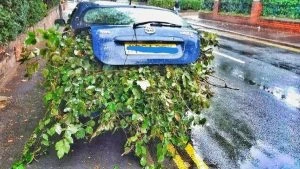
I need a bigger boot!